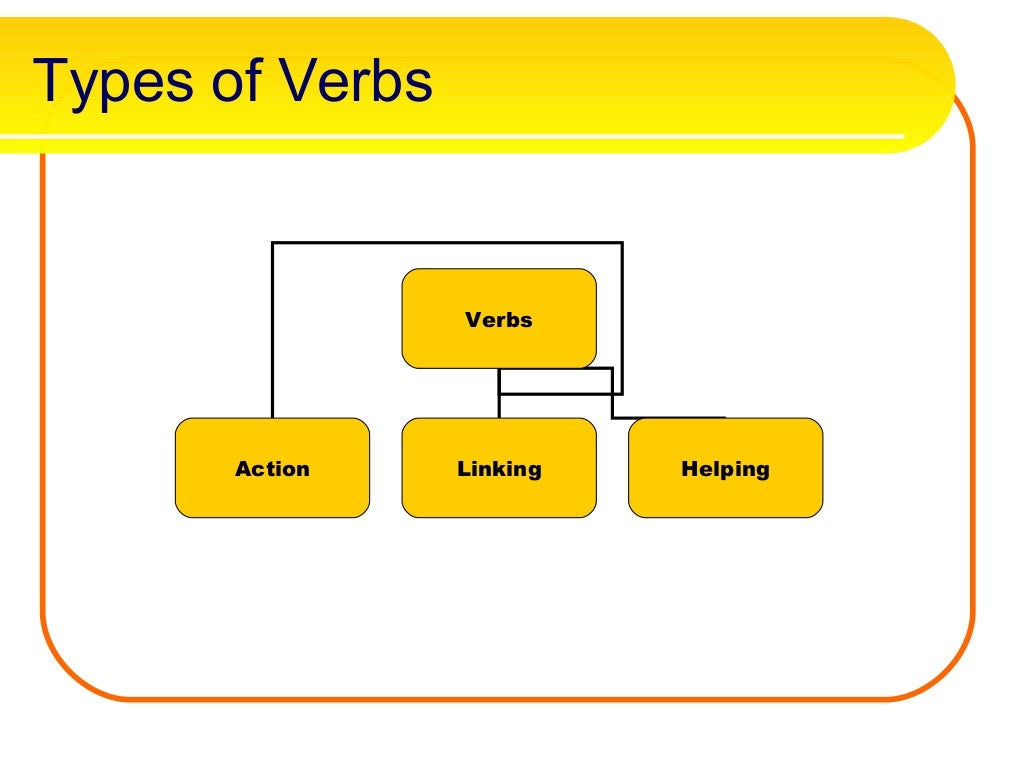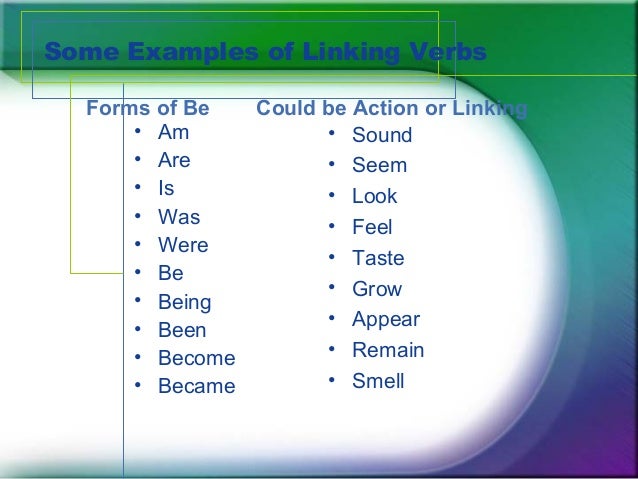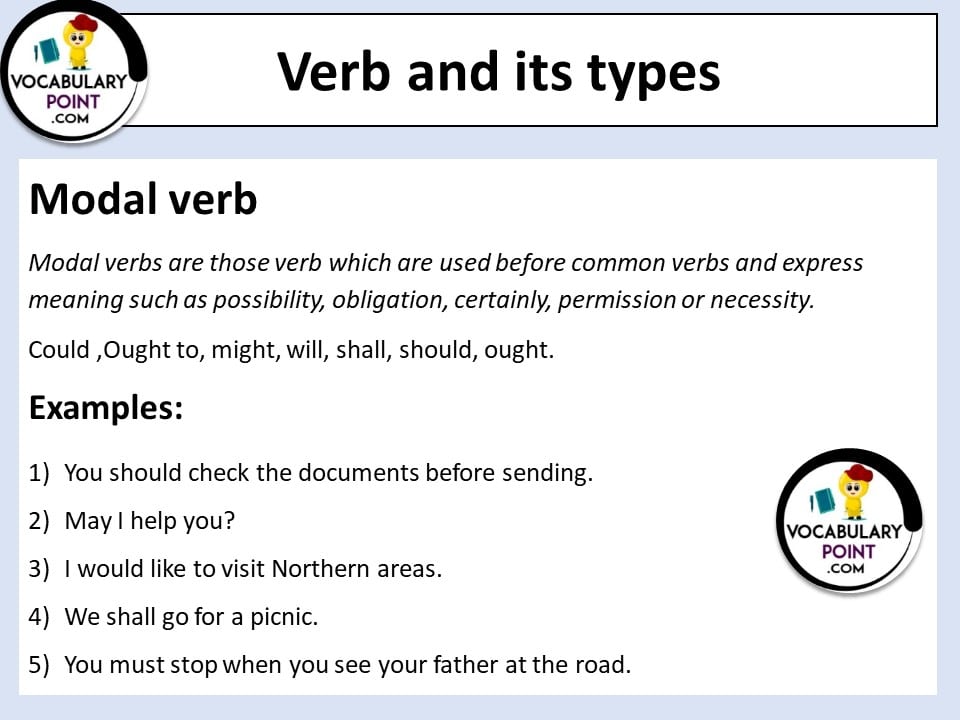The opposite of a transitive verb is an intransitive verb. A verb is an intransitive verb if it is not used with a direct object. Remember, only nouns, pronouns, and noun phrases can be direct objects. Prepositional phrases, adjectives, and adverbs cannot be used as direct objects.
Once again, both action and stative verbs can be used as intransitive verbs. Except for the linking verb list, the other categories break down into different types. The next list of verbs can be physical or mental. The list of helping verbs can be auxiliary or modal. The list of irregular verbs shows verbs in different tenses. Transitive VerbsTransitive verbs are action verbs that always express doable activities that relate or affect someone or something else.
In a sentence with a transitive verb, someone or something receives the action of the verb. When an action verb has no direct object, it's called an intransitive verb. An adverb or adverb phrase can follow intransitive verbs, but there will not be a direct object.
The being/linking words in the sentences above are included in the being verbs list below. You can use words in the linking verbs list to connect the subject with other words in a sentence. For the next little while, we're going to focus on main verbs.
So, forget about those poor little helping verbs for a bit, and let's turn our attention to action verbs and linking verbs. These two kinds of main verbs can act in four different ways. Linking verbs are a special type of stative verb whose name gives a big clue as to what they do.
Linking verbs are used to link a subject with a subject complement. A subject complement describes or identifies the subject of the sentence or clause. Linking verbs can function as intransitive verbs, which do not take direct objects.
There are three types of verbs; action, linking and helping. Most of the verbs you will use in conversation or writing will be action verbs or linking verbs. In the Indo-European languages, verbal adjectives are generally called participles.
English has an active participle, also called a present participle; and a passive participle, also called a past participle. The active participle of break is breaking, and the passive participle is broken. Other languages have attributive verb forms with tense and aspect.
This is especially common among verb-final languages, where attributive verb phrases act as relative clauses. Auxiliary verbs, or "helping verbs," are used in English to change another verb's tense, voice, or mood. When auxiliary verbs are used, there's always a main verb that represents the main action. However, the auxiliary verb must still be conjugated correctly.
Although there are a variety of auxiliary verbs in the English language, the following words are a few that often function as helping verbs. Note that these auxiliary verbs may function as action or linking verbs in other cases. Auxiliary verbs are also known as helping verbs and are used together with a main verb to show the verb's tense or to form a question or negative. Common examples of auxiliary verbs include have, might, will. These auxiliary verbs give some context to the main verb, for example, letting the reader know when the action took place. Intransitive verbs are action verbs that always express doable activities.
They are different from transitive verbs because there is no direct object following an intransitive verb. A transitive verb is a verb that is accompanied by a direct object in a sentence. The direct object is the noun, pronoun, or noun phrase that is having something done to it by the subject of the sentence. Both action and stative verbs can have direct objects, which means they can both be used as transitive verbs. The verb in a sentence expresses action or being. There is a main verb and sometimes one or more helping verbs.
("She can sing." Sing is the main verb; can is the helping verb.) A verb must agree with its subject in number . Verbs also take different forms to express tense. The auxiliary verbs, also called "helping verbs," allow you to write in various verb tenses and voices when combined with a base or main verb. Both modals and auxiliaries can be found on a list of helping verbs. Modals are usually followed by the infinitive of another verb. Just like the list of linking verbs, the list of modals within the list of helping verbs is also small and therefore easy to remember.
The words in the linking verbs list are words that connect the subject of a sentence to specific information about the subject. In other words, linking verbs connect the subject to a predicate noun or a predicate adjective. Such types of verbs cannot be the main verb of a clause or sentence as they do not talk about the action that is being performed by the subject or noun.
And they do not indicate any tense , mood or gender. All languages can express modality with adverbs, but some also use verbal forms as in the given examples. If the verbal expression of modality involves the use of an auxiliary verb, that auxiliary is called a modal verb. Helping verbs, also called auxiliary verbs, are helpful verbs that work with other verbs to change the meaning of a sentence. A helping verb combines with a main verb in order to accomplish different goals.
These include changing the tense of the verb or altering the mood of a sentence. The future tense is used to express circumstances that will occur in the future. The future tense is different from the present and past tenses in that there is not usually a type of verb conjugation that shows the future tense. Instead, future verbs are formed by combining them with words like will or shall, or the phrase going to. The different future tenses are simple future, future progressive, future perfect, and future perfect progressive.
Now you know more about transitive and intransitive verbs, start paying attention to them when you study. When you meet a new phrasal verb, make a note of whether it's transitive or intransitive so you know if you can separate the verb or not. And make your own examples too to help you remember them more easily.
Depending on the language, verbs may express grammatical tense, aspect, or modality. Grammatical tense is the use of auxiliary verbs or inflections to convey whether the action or state is before, simultaneous with, or after some reference point. Intransitive and transitive verbs are the most common, but the impersonal and objective verbs are somewhat different from the norm. The past participle is used for the perfect tenses. In regular verbs, it's the same as the simple past tense, so there's nothing extra to learn.
However, irregular verbs often use unique past participles, so you may have to memorize their forms. It is the main verb in an independent clause or a sentence. Finite verbs give information about gender, person, number, tenses, aspect, mood, and voice. This article includes definition, transitive and intransitive verbs with examples, usage of verbs in sentences. All this is simultaneously explained in Hindi and English for better understanding. Just as action verbs describe what a subject does, linking verbs describe the subject in some other way.
Most often, they define or describe the subject of the sentence. Note that in the two example sentences the linking verb connects the subject to its definition. In the first sentence, Jane is defined as a nice person; in the second sentence, the new cat is identified as a possible calico. Each of these sentences uses intransitive verbs. Look carefully and you will see that none of these sentences have direct objects. Verbs in future perfect express actions that will be completed in the future.
Use "will have" paired with the main verb in simple past tense. The next verbs list you'll look at is the list of action verbs that are irregular, thus they are part of the irregular verbs list. Well, verbs that do not follow the normal rules for conjugation fall into the irregular verbs list. These words could also be included on a list of action verbs describing physical motion. When you don't use these words in the literal sense, they become mental action words. In other words, these words could be found on both a physical and mental action verbs list.
A linking verb is a verb that describes the subject. Linking verbs connect the subject to a predicate noun or a predicate adjective. Linking verbs do not describe any direct physical or mental action of the subject or any action controlled by the subject. There is also a third category of verbs which doesn't get any glory. The reason that these guys don't get any of the fame that action and linking verbs get is because they don't stand alone as main verbs.
A verb that refers to action and links with the subject but does not have an object is called an intransitive verb. Intransitive verbs don't need an object to complete their proper meaning. Unlike action verbs, stative verbs refer to conditions or states of being.
Generally speaking, we use stative verbs to describe things like qualities, states of existence, opinions, beliefs, and emotions. When used in a sentence, stative verbs do not refer to actions. It is important to know that some verbs can be used as either action or stative verbs depending on their meaning in the sentence. We are less likely to use stative verbs in the continuous verb tenses.
Some words can be used as linking verbs or action verbs. With these words, it's important to consider the function the verb is performing in the sentence in order to identify the type. Verbs in future perfect progressive express a continuous, completed action that will have taken place in the future. Use "will have been" combined with the -ingform of the main verb. A verb is a word that expresses an action, describes an occurrence, or establishes a state of being. Every sentence needs at least one verb, which is paired with the subject.
All verbs have tense, aspect, and mood, of which there is a wide variety of combinations. These concepts are part of the foundation of accurately expressing your thoughts in writing. Auxiliary verb must connect to an action or linking verb to make sense, and auxiliary verbs exist to "help" verbs express tense, voice, or mood. Linking verbs can stand on their own in sentences as the main verb, even though they have very different functions. Sentences can have both action and linking verbs in the same sentence, but they have to be in separate clauses.
There are other verbs that can be both linking verbs and action verbs. All of the sense verbs; look, smell, touch, appear, sound, taste, and feel can be linking verbs. Other examples of verbs that can be linking verbs and action verbs include turn, remain, prove, and grow.
Modals or Modal Verbs or Modal Auxiliary are used to show the mood or attitude of the subject. They are the verbs that are used to indicate modality. Such as likelihood, ability, permission, request, capacity, suggestions, order, obligation, or advice. Modal verbs always accompany the base form of another verb having semantic content.
Modals are the type of auxiliary expressing the subject's mood. They give information about the function of the main verb. Here, the main verb is "finished", and the auxiliary"have"helps to express the perfect aspect. Some sentences contain a chain of two or more auxiliary verbs. Auxiliary verbs usually accompany the main verb.
The main verb provides the main semantic content of the clause. All the kinds of verb are explained with examples. Transitive verb, intransitive verb, linking verb, modal verb. Our last type of verb isn't actually a verb at all—sorry about that! However, infinitives look a lot like verbs because they are derived from them. An infinitive of a verb is identical to the base form of the verb.
For example, the infinitive form of the verb open is open. Typically, we use infinitives with the word to in order to form infinitive phrases. Infinitive phrases can be used for a variety of reasons, such as to act like nouns, adjectives, or adverbs. When we write sentences or clauses, we need to include a verb. A verb is a word that we use to refer to actions and states of being . For example, the words describe, eat, and rotate are verbs.






















